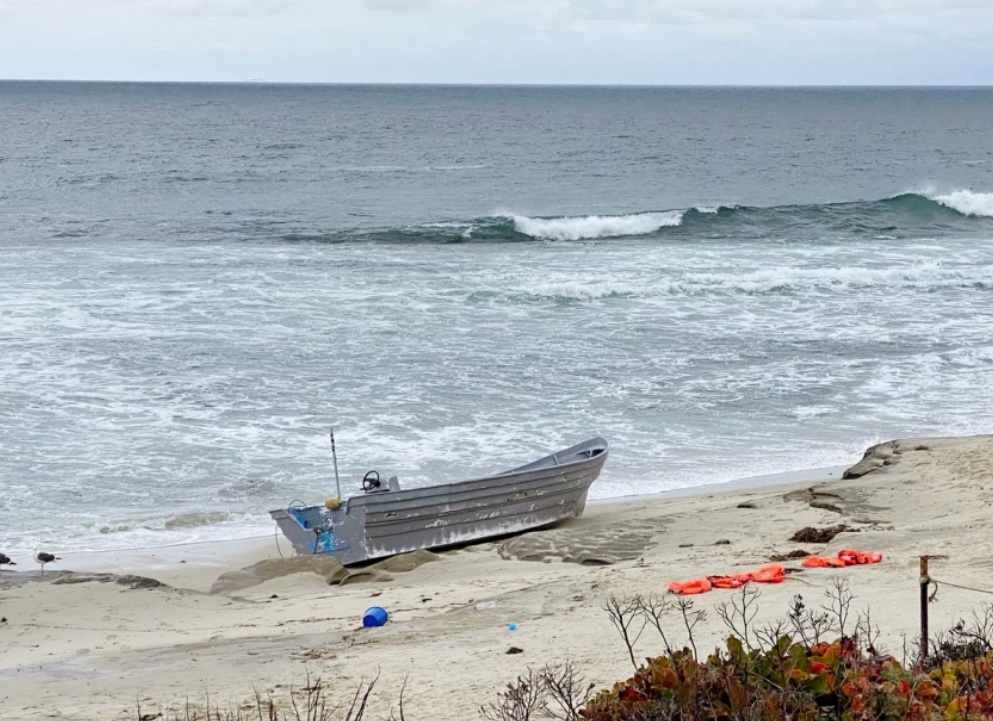
On August 18, 2021, Victor Alfonso Soto Aguilar and Jose Ramon Geraldo Romero pleaded guilty in federal court in connection with their roles as operators of a panga (skiff) that attempted to smuggle 14 Mexican citizens into the United States, ultimately resulting in the death of one passenger that happened when they beached their panga at Marine Street in La Jolla on May 20, 2021. All summer, local news and La Jollans have uploaded photos of these beached pangas on Facebook/Social Media at various locations in La Jolla like WindanSea, Bird Rock, Sea Lane, Marine St. and the Shores. So is this something new?
The links below tell a smuggling story for 2021.
So the short answer is hardly — it started to make headline news over ten years ago! And it is not uncommon to find more than one panga, in one day, abandoned.
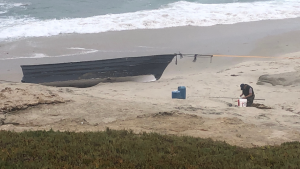
A BIT OF HISTORY BEFORE WE GET INTO MORE QUESTIONS OF WHY
San Diego has always had a history of smuggling, beginning in the pirate days where the caves in La Jolla were used to hide their contraband.
During probation, smuggling alcohol in from Mexico was widely done. The movie Lucky Lady, starring Gene Hackman, Liza Minnelli, Burt Reynolds, was all about smuggling alcohol off San Diego/Mexico.
For human smuggling! After an influx of immigrants in the 1800s (in 1868 alone, more than 12,000 Asian workers had come across the Pacific by the boatload to work on the railroad), rising prejudice led to strict immigration laws. These harsh restrictions began what was essentially the first commercial smuggling of human cargo in San Diego and throughout the United States. The La Jolla caves provided shelter for local pirates looking to make a buck off cheap labor.
The U.S. southern border is the most vulnerable of all borders in the world. 80% of all illegal/smuggling activity in the world happens at this very lucrative place. Now add the ruthless cartels with unlimited funds, high-tech knowledge and a very sophisticated, tactical military-run organization that’s similar to a Marxist-style government, and we have the perfect storm of illegal activity in San Diego.
WHY THE PANGA?
The panga changed the world in local fishing and has also become the perfect smuggling boat. It was developed in La Paz, Baja California Sur, in the late 1960s. The panga is simple — no inside floor, no cockpit, simple bench seats (that also add support for the rails), no extraneous beauty marks — but it has superior handling and capacity. It ranges in length from 22 to 28 feet and has a high bow that’s perfect to cut through swells. It is built in fiberglass and very lightweight. A couple of people can launch it from lots of secluded locations south of Tijuana (TJ). It’s long and narrow for speed. One of its key designs is the high rails that protect it in open seas and allows for more [human] weight.
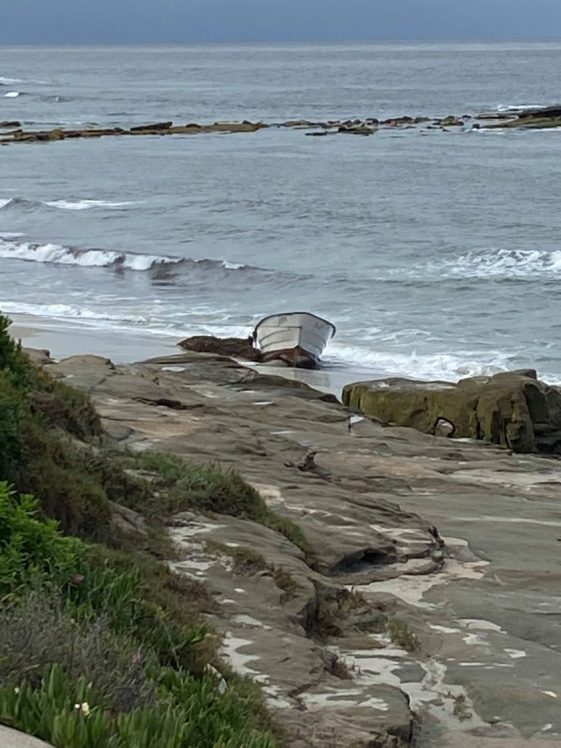
Now add the panga’s trademark color of a white hull (sometimes painted in gray to blend in with the ocean more as the one photo shows) and turquoise inside, and it suddenly becomes camouflaged: It’s almost impossible to see when it’s only a quarter-mile from shore. And it’s cheap to buy new for as little as $1200, or one can buy a used panga for as little as $200. Now add a 75-150 HP. outboard, and you have around a $3500 investment, pocket change for the cartel with the panga’s most valuable asset — the high rails — they can hold up to 25 plus people, but usually it’s around 15 people.
The biggest drawback on the panga is the ride. It is not comfortable. They are bumpy, noisy, and the vibration from the thin fiberglass hull, when going through choppy ocean can really scare the passengers into thinking the boat’s going to break apart. It is just one of the things the captains have to deal with, which is why one rarely sees women and children in these boats. Nothing is worse than a flipped-out cargo, as we learned reading about the Marine St. incident. And sadly, some captains are ruthless: One bullet and the problem is solved, and its psychological effect keeps the rest of the cargo in line.
It’s all about violence and greed!
WHY SAN DIEGO?
San Diego is unique in geographic location. Unlike other border towns, TJ is the second largest city in Mexico, and San Diego’s San Ysidro border is the world’s fourth-busiest land border. Just the pedestrian traffic is over 10 million crossings a year. With that said, it attracts tens of thousands of migrants from all over the world, and both cities blend with their Hispanic populations. TJ has become an “international migrant hub” – It’s easier to get into Mexico from Asia, South America and Africa before trying to get into the U.S.
WHY LA JOLLA?
La Jolla just happens to be the first coastal community (only 30 miles from the border) that has small, hidden coves tucked into a rocky coastline, not miles long with open, sandy southern beaches of the Coronado Strand, Ocean Beach, Mission Beach or Pacific Beach and not dangerous like the rocky coast of Point Loma’s Sunset Cliffs. La Jolla has also become the area were U.S. Border agents look for pangas, and you see them all the time cruising the beaches.
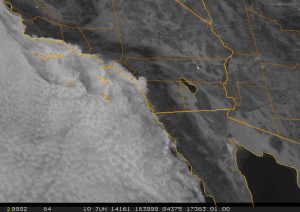
La Jolla’s summer weather is infamously known as “May gray” and “June gloom.” The marine layer is a low-lying mass of hazy, moist air that forms over the ocean and usually gets blown ashore at night, which provides perfect cover for pangas.
This also affects the range/clarification of radar on nearby Point Loma and La Jolla’s Mount Soledad by diffusing the beam, thus hindering the ability of it to clearly recognize a small target like the panga is. I will get into why radar is not as effective a bit later.
Some of the prime locations are just north of La Jolla’s southern community of Bird Rock where there are a few hidden coves and beaches with access between the clustered, heavily landscaped and multi million-dollar bluff homes overlooking the ocean.
Growing up in La Jolla, we referred to these beaches as “secret beaches.”
Now, moving a bit north, the bigger beaches — WindanSea, Marine St., Sea Lane and La Jolla Shores — also provide nice unloading spots. But let’s not discount farther north like Black’s Beach, Del Mar and Encinitas, what also get their fair share of smuggling action.
HOW INVOLVED IS THE CARTEL?
The cartel controls just about all illegal activity at the border, period! And the cartel lets everyone know that. Recently they welcomed the new TJ police chief with a severed head (calling card of the cartel) sending a message of who is really in charge.

Anyone who walks across the border into Mexico sees it.
One of the first things you see when entering through Mexico’s pedestrian crossing is small groups of people with knapsacks, backpacks or holding onto some large plastic bag that contains just about everything they own. Hang around long enough, and you will see men approaching, offering their services.
The cartel is very visual hustling would-be-crosser(s) to pay anywhere from a few $100 to $1000s to be smuggled in.
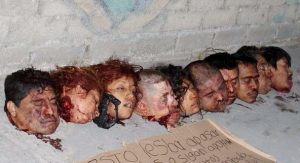
Also taxi drivers working around TJ’s bus and airport terminals hunt for these out-of-towners and get a finder’s fee that varies from $50 to $100 per person. Kids get one half off — just kidding — but you get the point. It’s a very profitable side job with zero risks.
When migrants manage to get to TJ, it is very discouraging to see the long lines at the Mexican pedestrian crossing. It is not uncommon to see a van or pickup truck pull up, and the migrants jump into it. Federal police are bribed to let it happen, or they just don’t care, as it is a way to clean out the already congested border.
AGAIN, WHY SAN DIEGO?
Two other quick answers are, ocean traffic and the Pythagorean theorem. Pythagorean? We will get into that a few questions later. On many days there can be as many as 50 to 75 boats off San Diego. They vary from military ships to medium and large commercial ships, and, more importantly, small pleasure and sport-fishing boats that literally jam up the many radar stations, providing major cockblocking for pangas operating illegally.
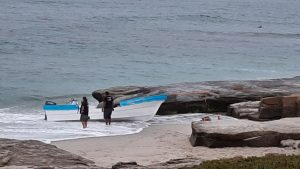
During yellowtail and tuna season, which is the beginning of summer, there can be a 30-to-60-minute wait just to launch your boat at San Diego Bay. Now add several Mission Bay launch ramps, and it can be a freight train of fishermen heading out in various crisscrossing directions.
YOU HAVE MENTIONED RADAR. WHY ISN’T IT AFFECTED? AND WHAT ABOUT DRONES?
Once again, San Diego is unique. There are many radar tracking stations all over — everything from weather to traffic control and even the secret ones used for surveillance at Point Loma Naval Center.
San Diego has more airports per square mile than anywhere in the world, starting with San Diego International Airport, four military air bases, Marine Corps Air Station Miramar, Camp Pendleton (with three small airfields), Coast Guard and Naval Air Station North Island, and now add four medium-size municipal airports (Brown Field in Otay Mesa, McClellan-Palomar, Gillespie and Montgomery) and 16 smaller airfields. Then to really throw a monkey wrench into the cluster, there is Tijuana International Airport, which is within spitting distance from Brown Field.
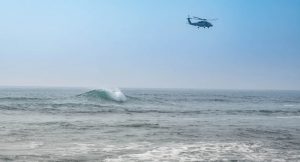
Traffic controllers are congested and overwhelmed with keeping tabs on air traffic. The last thing they need is a drone operating in the vicinity. Besides the military and Lindberg air traffic, whose flight takeoff pattern is out over the ocean, we can add the Coast Guard and nearby Marine base, Camp Pendleton, and Miramar helicopters. All these copters are cruising the coast day and night. So we have an airspace cluttered in never-ending air traffic.
WHY AREN’T AWACS USED?
San Diego is not like Florida where there is a great deal of ocean that’s spread out over hundreds of miles of Florida’s coastline (huge sky land) and where AWACS can single out and follow a lone boat ripping across a vast field of ocean at 40 to 50 knots with two tons of cocaine. In San Diego, the area is way too small for eye-in-the-sky AWACS. So we add the condensed ocean traffic from both countries where AWACS technology is not advanced enough to single out and determine if it’s a Mexican smuggler out of 20 plus boats filled with U.S. fishermen heading as far west as the Cortes and Tanner Banks for some rock cod or tuna fishing.
Some of these captains have been known to also carry car radar jammers. How effective they are is unclear.
WHAT’S THIS ABOUT THE PYTHAGOREAN THEOREM?
Let’s face reality, smugglers like this part. The earth’s curve pays an important role. When one is out ONLY 5 miles, the earth curve drops about 4 feet, out of site from the 3-to-4-foot rails on the panga, and just a couple of miles more, almost 8 feet because the curve distance is greater, as the diagram shows. Out only 18 miles, there is no physical structure high enough with a radar device in San Diego to see the low-riding panga cruising with illegal cargo.
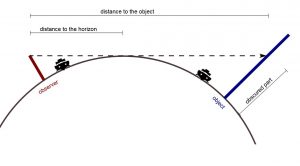
What these captains do is launch from some hidden cove or beach south of TJ, then head between the Coronado Islands, which is usually spotted with Mexican and U.S. fishermen, then keep heading northwest until they reach the 5-plus-mile mark.
Now add the commercial shipping lanes that are only about 4 to 7 miles out. So it’s a lot easier to conceal themselves between both north- and southbound shipping. Captains on these commercial ships, or any others, do not care when they see these blips on their radar screen … They only care if the boat is steering and moving out of their way.
Pangas have no running lights and will usually shadow another boat or several because all boats, by maritime law, are required to use running lights at night. Since the hull of the panga is white, it reflects light, and radar will/can pick this up as a ghost imaging, which only adds to the operator’s confusion of an already congested area.
Prime time for smuggling is the summer months where boating activity jumps 500%, helping to block the detection of these stealth-like pangas. Now add the flow of pleasure/fishing boats heading to San Clemente Islands (off Long Beach), and it becomes another perfect concealment for those pangas unloading their illegal cargo to places farther up north like Ventura and Santa Barbara.
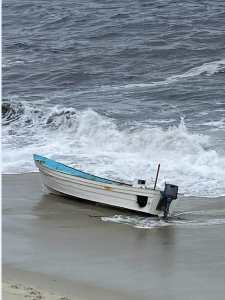
HOW MUCH DO THESE CAPTAINS GET PAID?
Look at it this way: A Mexican panga fisherman is lucky to make $50 a day, so the temptation of making thousands becomes more appealing to moonlight as a smuggler. Captains vary in experiences and in pay. And it is not only a one-way trip. Some captains carry burner phones or small GPS devices, but most rely on visibility. A good captain can make up to $2500 per trip or more, depending on how far they must travel to unload their cargo.
One captain who was caught confessed. It was his 12th trip within a four-month period of time. And another said, “It’s a carnival,” when referring to how many want to enter the U.S. illegally.
BURNER PHONES?
The Burner Phone (or advertises as Pay-As-You Go Plans with one number per phone) is the perfect communication device because they are untraceable. You can buy them just about anywhere, especially at large department stores like Walmart, for as little as $9. These phones are bought by the case with cash and handed out like candy to the human cargo. Phones have one contact number to another burner phone. Or the mule (someone who is paid or in many cases forced to smuggle) is given a number. There main purpose: Let the cargo know where they are, just in case they have to scramble to avoid being captured.
WHAT TYPE OF ILLEGAL CARGO IS MOST USED?
There are only two types of illegal cargo: 1) humans, and 2) drugs. Both are the most profitable. Human cargo pays anywhere from $1000 to $15,000 per person, depending on where they get dropped off. Drugs are a whole different ballgame. Rarely will you see just drugs in these pangas because of the labor and time needed to offload and the timing of that labor to meet with the boat. It’s 20 times faster to unload human cargo, so most drugs are transported with illegals wearing packs that can hold as much as 100 lbs. And if a panga is used for drugs only, it’s usually unloaded on some larger vessel offshore. One pound of cocaine is worth around $10,000 wholesale, so each person could potentially carry approximately $1 million in illegal product that’s worth ten times that much on the retail market. Now times that by ONLY ten mules/passengers. Even one with a fifth grade education can figure out the money involved.
WHAT TYPE OF DRUGS?
South American cocaine, China fentanyl and Eastern heroin/opium is what’s smuggled the most. So you can see why Mexico and its corruption has become the hub of drugs. Marijuana not so much because it is bulky and nowhere near as profitable. And with more states legalizing it, there is no real demand.
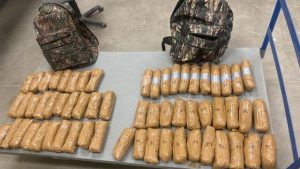
However, the cartel can be most ruthless, threatening their human cargo, and in some cases, holding loved ones hostage if the innocent just want to come into the U.S. and they do not carry drugs. Or they can suddenly raise the price, forcing the innocent to carry drugs to pay for the trip. Some will give them money to become a mule, which is also very appealing; a bit of startup money in exchange for a new life in the U.S., considering the trip to get to TJ has cost them everything they own. This money is usually a lot less (anywhere from several hundred to maybe $1000) than what they will pay for a professional mule. A professional mule can make upwards to several thousand.
It’s fairly simple. Once a mule or mules are dropped off, they call on their burner phone for a pickup to unload their cargo and a ride back to the border. Then the whole process starts again.
WHAT ARE THE ODDS OF A SUCCESSFUL TRIP?
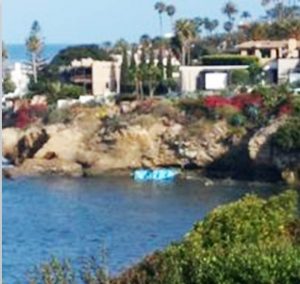
Again, the short answer: No one really knows. U.S. Border Patrol estimates between 30 to 50% of the illegal foot traffic DOES NOT get caught. The U.S. Border Patrol reported nearly 200,000 encounters with migrants along the U.S.-Mexico border in July 2020, the highest monthly total in more than two decades. In the year 2021, that has jumped to record numbers.
As for ocean-bound, residents that live on the coast below TJ say it is not uncommon to see pangas picking up cargo at just around sundown or a few hours past. This allows an ample amount of night travel to get to their destination and unload. Now times that by several locations, and you can get a fair estimate of what gets through … to who gets caught.
You would think that most that do get caught, the captain had some sort of engine problems so they beach the boat at the closest location. If that was true, then how would they be able to run up on the beach?
One thing for sure, nobody knows what’s going on in a captain’s mind as that panga is pounding through the dark and eerie ocean with a boatload of scared passengers, many of which had never been on a boat before.
But we do know two reasons for getting caught:
- The captain was inexperienced and made an error in navigational judgment like the Point Loma/Sunset Cliffs incident where the boat ran aground on a reef.
- The human cargo starts to panic after hours of getting beat to hell on the open sea and demands (a mutiny) to be put ashore, regardless of where. As the testimony of one said during the trial of the Marine St. incident, “We feared for our lives during the journey.”
Even if the ocean-bound smuggler is not as widely used (only around 5%) as crossing by foot or by cars/trucks, it still is one of the best odds to get their product into the U.S., but it is the most expensive for the human cargo. And as we all know, percentage wise, you make more money at the $2 window … than at the hundred-dollar window.
Then we think about the one captain who made 12 trips without being caught.
Special Thanks to Michael and Melinda for reviewing the article for format and content continuity.
